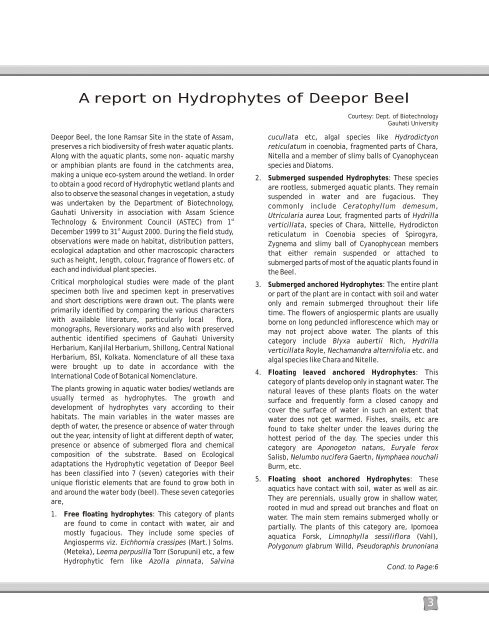Query Form - ENVIS Assam
Query Form - ENVIS Assam
Query Form - ENVIS Assam
Create successful ePaper yourself
Turn your PDF publications into a flip-book with our unique Google optimized e-Paper software.
A report on Hydrophytes of Deepor Beel<br />
Deepor Beel, the lone Ramsar Site in the state of <strong>Assam</strong>,<br />
preserves a rich biodiversity of fresh water aquatic plants.<br />
Along with the aquatic plants, some non- aquatic marshy<br />
or amphibian plants are found in the catchments area,<br />
making a unique eco-system around the wetland. In order<br />
to obtain a good record of Hydrophytic wetland plants and<br />
also to observe the seasonal changes in vegetation, a study<br />
was undertaken by the Department of Biotechnology,<br />
Gauhati University in association with <strong>Assam</strong> Science<br />
st<br />
Technology & Environment Council (ASTEC) from 1<br />
st<br />
December 1999 to 31 August 2000. During the field study,<br />
observations were made on habitat, distribution patters,<br />
ecological adaptation and other macroscopic characters<br />
such as height, length, colour, fragrance of flowers etc. of<br />
each and individual plant species.<br />
Critical morphological studies were made of the plant<br />
specimen both live and specimen kept in preservatives<br />
and short descriptions were drawn out. The plants were<br />
primarily identified by comparing the various characters<br />
with available literature, particularly local flora,<br />
monographs, Reversionary works and also with preserved<br />
authentic identified specimens of Gauhati University<br />
Herbarium, Kanjilal Herbarium, Shillong, Central National<br />
Herbarium, BSI, Kolkata. Nomenclature of all these taxa<br />
were brought up to date in accordance with the<br />
International Code of Botanical Nomenclature.<br />
The plants growing in aquatic water bodies/wetlands are<br />
usually termed as hydrophytes. The growth and<br />
development of hydrophytes vary according to their<br />
habitats. The main variables in the water masses are<br />
depth of water, the presence or absence of water through<br />
out the year, intensity of light at different depth of water,<br />
presence or absence of submerged flora and chemical<br />
composition of the substrate. Based on Ecological<br />
adaptations the Hydrophytic vegetation of Deepor Beel<br />
has been classified into 7 (seven) categories with their<br />
unique floristic elements that are found to grow both in<br />
and around the water body (beel). These seven categories<br />
are,<br />
1. Free floating hydrophytes: This category of plants<br />
are found to come in contact with water, air and<br />
mostly fugacious. They include some species of<br />
Angiosperms viz. Eichhornia crassipes (Mart.) Solms.<br />
(Meteka), Leema perpusilla Torr (Sorupuni) etc, a few<br />
Hydrophytic fern like Azolla pinnata, Salvina<br />
Courtesy: Dept. of Biotechnology<br />
Gauhati University<br />
cucullata etc, algal species like Hydrodictyon<br />
reticulatum in coenobia, fragmented parts of Chara,<br />
Nitella and a member of slimy balls of Cyanophycean<br />
species and Diatoms.<br />
2. Submerged suspended Hydrophytes: These species<br />
are rootless, submerged aquatic plants. They remain<br />
suspended in water and are fugacious. They<br />
commonly include Ceratophyllum demesum,<br />
Utricularia aurea Lour, fragmented parts of Hydrilla<br />
verticillata, species of Chara, Nittelle, Hydrodicton<br />
reticulatum in Coenobia species of Spirogyra,<br />
Zygnema and slimy ball of Cyanophycean members<br />
that either remain suspended or attached to<br />
submerged parts of most of the aquatic plants found in<br />
the Beel.<br />
3. Submerged anchored Hydrophytes: The entire plant<br />
or part of the plant are in contact with soil and water<br />
only and remain submerged throughout their life<br />
time. The flowers of angiospermic plants are usually<br />
borne on long peduncled inflorescence which may or<br />
may not project above water. The plants of this<br />
category include Blyxa aubertii Rich, Hydrilla<br />
verticillata Royle, Nechamandra alternifolia etc. and<br />
algal species like Chara and Nitelle.<br />
4. Floating leaved anchored Hydrophytes: This<br />
category of plants develop only in stagnant water. The<br />
natural leaves of these plants floats on the water<br />
surface and frequently form a closed canopy and<br />
cover the surface of water in such an extent that<br />
water does not get warmed. Fishes, snails, etc are<br />
found to take shelter under the leaves during the<br />
hottest period of the day. The species under this<br />
category are Aponogeton natans, Euryale ferox<br />
Salisb, Nelumbo nucifera Gaertn, Nymphaea nouchali<br />
Burm, etc.<br />
5. Floating shoot anchored Hydrophytes: These<br />
aquatics have contact with soil, water as well as air.<br />
They are perennials, usually grow in shallow water,<br />
rooted in mud and spread out branches and float on<br />
water. The main stem remains submerged wholly or<br />
partially. The plants of this category are, Ipomoea<br />
aquatica Forsk, Limnophylla sessiliflora (Vahl),<br />
Polygonum glabrum Willd, Pseudoraphis brunoniana<br />
Cond. to Page:6<br />
3


